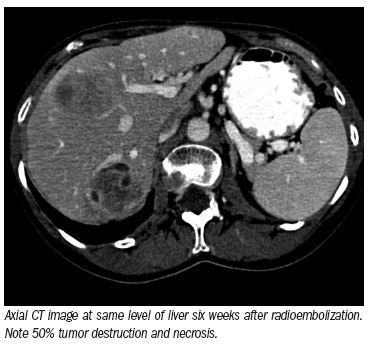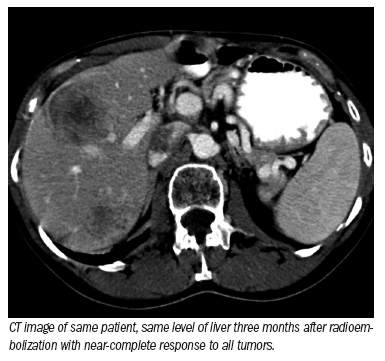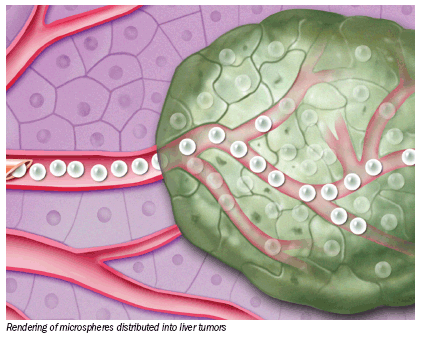Targeted therapies gain groundon hard-to-treat liver tumors
Not long ago, our approach to treating difficultmetastatic tumors was to "spray and pray." Weknew that chemotherapy and other traditionaltreatment approaches could cause great damageand had a limited chance of successfully destroyingthe entire tumor.
Not long ago, our approach to treating difficult metastatic tumors was to "spray and pray." We knew that chemotherapy and other traditional treatment approaches could cause great damage and had a limited chance of successfully destroying the entire tumor. At the time, a proven safer and more effective option did not exist, and patients were desperately in need of treatment. Fortunately, as our knowledge of the complexities of advanced liver tumors has grown, so has our ability to develop treatments that target and treat tumors while avoiding harmful side effects to normal tissue.
TREATMENT CHALLENGES
Over the past 10 years, we have noticed a shift toward targeted therapies in numerous tumor types of cancer, including breast, lung, lymphomas, and colorectal. Some of the most significant treatment advances have been realized with the development of targeted and innovative therapies to treat liver tumors. Historically, these types of tumors are difficult to treat, making liver cancers some of the deadliest forms of cancer. Colorectal liver metastases present one of the greatest challenges. Each year, more than 150,000 U.S. patients will be diagnosed with colorectal cancer, and at least 80% will see their cancer spread to the liver.
Unfortunately for those diagnosed, options for treating metastatic liver tumors are few. The liver's unique anatomy presents numerous challenges when evaluating conventional treatments. Since fewer than 20% of liver tumors can be surgically resected, metastatic liver cancer is often fatal, with up to 90% of patients dying from liver failure.

Chemotherapy is considered the gold standard of care, but it is often not optimal given the fact that, over a long period of time, the cancerous tumors become unresponsive and grow despite more chemotherapy. In the past, radiation therapy for liver tumors has proven especially challenging due to limitations on our ability to deliver a lethal dose without killing healthy liver tissue.
The sheer paucity of treatment options forced physicians to look for alternatives that offered efficacy without the damaging side effects. This didn't happen overnight. Targeted treatments are a natural progression from decades of research that saw less specific anticancer agents destroy tumors-but at the cost of normal tissue.
Advances in the technology of radiation therapy, medical oncology, radiology, and surgery have greatly reduced collateral damage to normal tissue and thus enabled improved outcomes. By reducing the threat to normal tissue, these advances also allow us to deliver higher doses of drugs and radiation to tumors.
MICROSPHERE DEVELOPMENT

Research into the use of yttrium-90 microspheres for the treatment of liver cancer actually began in the 1960s. However, it wasn't until much later that researchers became able to embed radioactive elements into a consistently manufactured microsphere of the correct diameter that could travel easily in the bloodstream to the capillary bed of the liver tumor. Today's microspheres are microscopic radioactive spheres that can be delivered by the millions directly to the site of a cancer, where they selectively irradiate the tumors.
During the procedure, called selective internal radiation therapy (SIRT) or radioembolization, a targeted high dose of radiation is delivered to liver tumors. The treatment is performed as an outpatient procedure in radiology and requires the placement of a transfemoral microcatheter that is positioned in the hepatic artery.
Using the liver's unique vascular supply, millions of tiny microspheres charged with Y-90 are released into the hepatic artery in a carefully chosen location unique to that patient. The radioactive microspheres become implanted in the microvascular supply of the tumor where they become permanently trapped. The microspheres emit beta radiation over a period of two weeks.
Two forms of microsphere therapy are in use today: SIR-Sphere microspheres are made of resin, and TheraSphere's of glass. SIR-Sphere, manufactured by Sirtex, was approved by the FDA in 2003 and marked the first entry in the U.S. market of this form of targeted therapy for advanced liver tumors.
It is currently the only microsphere therapy approved by the FDA for use in treating colorectal liver metastases.
TheraSphere is manufactured by MDS Nordion and is available in the U.S. for treatment of hepatocellular carcinoma under a humanitarian device exemption from the FDA. Over time, our research regarding the role of microspheres has expanded to treating primary liver tumors, carcinoid tumors, and other forms of liver metastases originating in the breast and lung as well as ocular melanoma.
CLINICAL PRACTICE
The targeted nature of SIRT allows us to deliver 40 times more radiation directly to tumors than is possible with conventional radiation, resulting in extremely high response rates with very few serious adverse events.
This finding is particularly surprising given that the liver is one of the most radiation-sensitive organs in the body.
But chemotherapyinsensitive, unresectable tumors are being completely destroyed with a single treatment.
Microsphere therapy is succeeding where everything else has failed, especially when used early in the disease course. Microspheres have also been found to be more effective when given concurrently with state-of-the-art chemotherapy.

In our practice, we mostly use microspheres without concurrent chemotherapy, as a majority of patients are on a chemotherapy "break" to recover from some side effects, or their cancer is not responding to the current "best" chemotherapy.
Many less common tumors that do spread to the liver are also being eradicated. This is rewarding, since we are able to provide patients with a better quality of life with fewer side effects while in treatment and extend their life expectancy despite a disease state for which no treatment was previously available.
Due to significant advances in technology, the use of radiation therapy for liver tumors has increased greatly and is offered at hundreds of medical centers across the country. A recent report by the Millennium Research Group stated that embolization particle therapies such as radioembolization spheres are increasingly being used to treat liver cancer.
MRG anticipates that radioembolization procedures will increase at a compound annual growth rate of almost 20%, thanks to a growing number of institutions adopting radioembolization techniques and increased reimbursement coverage.
GROWING BODY OF RESEARCH
At the 2008 American Society of Clinical Oncology annual meeting, researchers from the Italian Society of Locoregional Therapies in Oncology reported data from a phase II study evaluating the use of microspheres in patients with advanced colorectal liver metastases refractory to standard chemotherapy. According to the prospective trial, the use of Y-90 microspheres resulted in a median survival of 13 months.1
Just two years earlier, a study published in the International Journal of Radiation Oncology Biology Physics2 found that the use of radioembolization in a similar patient population resulted in a median survival rate of 10.5 months. This illustrates how we are using this growing body of information to even further refine patient selection, dosing, and administration of targeted therapies.
Other important research includes a seminal paper by Kulik3 and colleagues in HCC patients with and without obstruction of the portal vein treated with Y-90 microspheres. A total of 108 patients from two medical centers were treated in a phase II study with excellent follow-up. In this very difficult patient population, exciting long-term survival was seen with few adverse events.
Liver metastases from neuroendocrine tumors are the subject of three new reports with impressive response rates and improvement in carcinoid symptoms.4-6 This patient group is especially challenging as there are few active chemotherapy regimens to use, and liver metastases are a major source of pain, carcinoid syndrome, and eventual death.
WHAT THE FUTURE HOLDS
While we have made great strides in using targeted treatments to provide patients safer and more effective treatment options, the truth is we are only beginning to learn how we can best utilize these therapies to further improve survival rates. Further research will allow for more selective imaging of tumors and antitumor effects. Investigators are also working to develop more specific anticancer cell agents and increase our ability to irradiate small tumors in critical areas, either by implanting radiation (brachytherapy) or via external beam. Improvements in and use of 4D radiation treatment planning and image-guided and intensity- modulated radiotherapy push the frontiers of externally delivered radiotherapy, and they are helping more patients than ever.

As physicians, it is critical that we embrace the opportunities that targeted and innovative therapies bring to bear. These treatments, once considered renegade by many in the medical community, are now being accepted and used in conjunction with traditional therapies. Just as no two cancer cells are alike, there is no one-size-fitsall approach to treating metastatic tumors. As research continues to evolve, so will the options we can offer to our patients. By targeting tumors with the most effective doses of medication in the most efficient ways possible, we will continue to make great strides in improving patient survival rates and, equally important, patients' overall quality of life.
The Reading Room: Artificial Intelligence: What RSNA 2020 Offered, and What 2021 Could Bring
December 5th 2020Nina Kottler, M.D., chief medical officer of AI at Radiology Partners, discusses, during RSNA 2020, what new developments the annual meeting provided about these technologies, sessions to access, and what to expect in the coming year.
Strategies to Reduce Disparities in Interventional Radiology Care
March 19th 2025In order to help address the geographic, racial, and socioeconomic barriers that limit patient access to interventional radiology (IR) care, these authors recommend a variety of measures ranging from increased patient and physician awareness of IR to mobile IR clinics and improved understanding of social determinants of health.